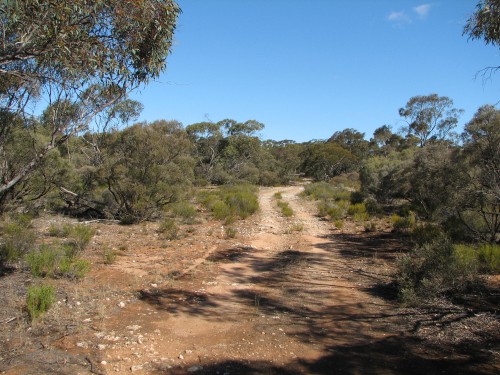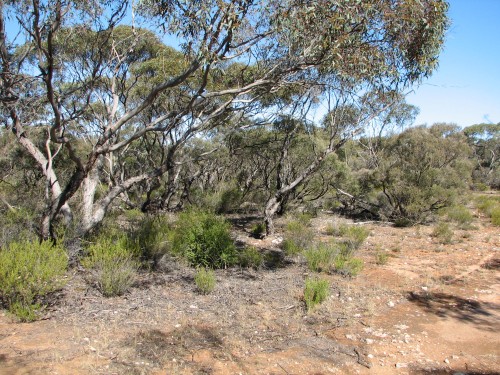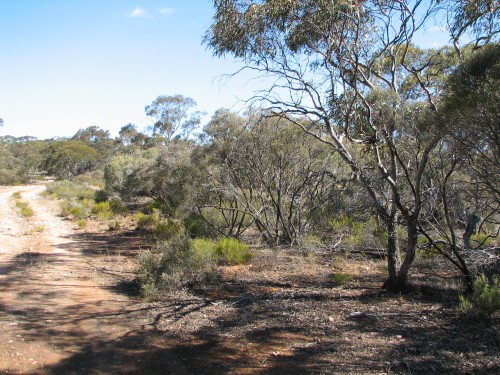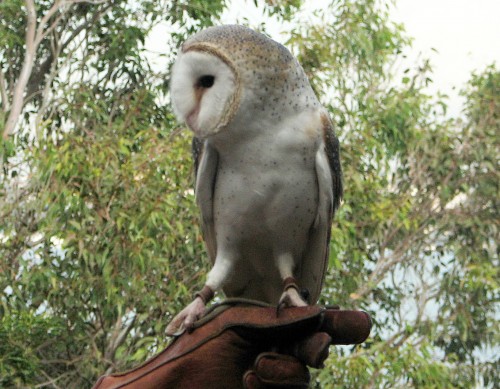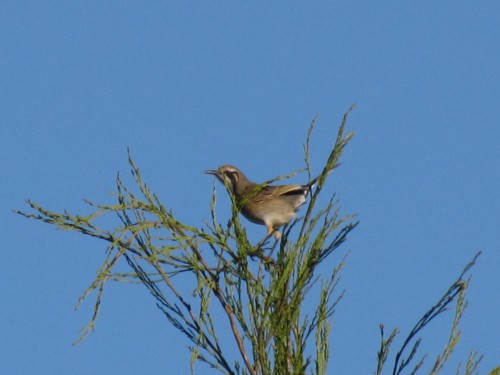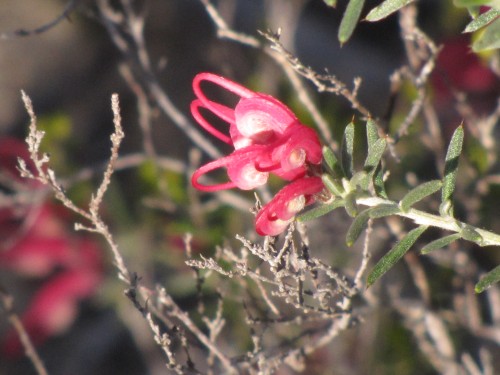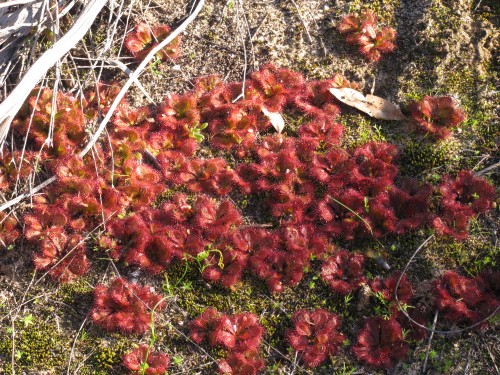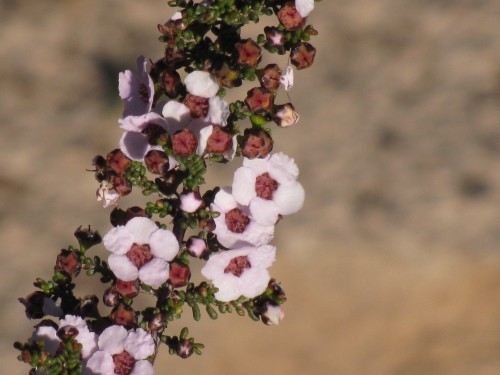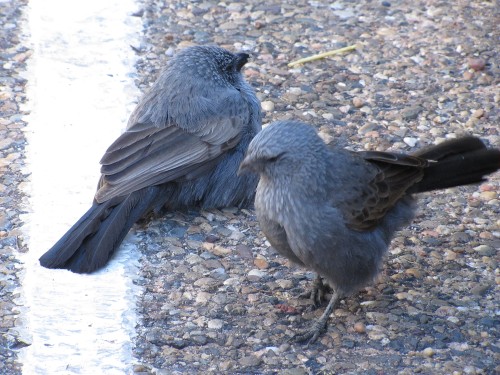Birding in Lowan Conservation Park
A few Sundays ago we had a break in our cold, wintry weather and we went for a drive to Lowan Conservation Park, a 40 minute drive north east from home in Murray Bridge, South Australia. The park is about 15 kilometres south east of Bowhill. I had visited this park on several previous occasions and found that the birding can be either a feast or a famine; it all depends largely on what is in flower, or the weather conditions.
The park is predominantly mallee woodland (see photos) with a mixture of other smaller scrubs and bushes. My wife has written about some of the plants on her site here.
On our most recent visit I didn’t even bother to take any photos; I saw no birds to photograph, well, none within range. And while we had our picnic afternoon tea in the sun I heard very little. It was a real struggle to get a short list of birds – mostly heard. (PS The photos on this post were taken on another visit.)
Bird list:
- Little Raven
- Mallee Ringneck
- Grey Shrike-thrush
- Weebill
- White-winged Chough
- Singing Honeyeater
- Australian Magpie
- Grey Butcherbird
- Galah
- Grey Fantail
- Noisy Miner? (or Yellow-throated Miner? – I only heard them)
- Striated Pardalote
That is not a great list, but there was not much flowering. In a park of some 660 hectares one would expect far more honeyeaters, but the mallee has to be in flower. Honeyeater species I would expect to see – or already have seen on other occasions – include: Striped, White-fronted, White-eared, White-plumed, Spiny-cheeked, Purple-gaped, Yellow-plumed, Brown-headed, New Holland and Red Wattlebird.
In addition to the honeyeaters I would expect to see more parrots, pigeons, wrens, thornbills, chats, woodswallows, robins (I did see one, but it flew off before I could get a positive ID), owls, nightjars, frogmouths, swallows, cuckoos, eagles, kites, falcons and even a Malleefowl or two. I have seen two Chestnut Quail-thrush there many years ago; I hope that they are still around.
I guess that the best time to visit would be in the spring, when there is a chance of more flowers. I think that it might be worth camping there overnight. By the way – there is only a rough, stony and sometimes sandy track through the park and NO facilities at all.
Trevor
Further reading:
Cold weather birding
I didn’t do much birding today.
Or yesterday.
I decided that the weather was far too cold. We are having a really cold winter’s snap here in South Australia with heavy rain, very cold temperatures, blustery winds and even snow. Snow in our state is such a rarity it receives plenty of coverage in the news. We average one snow fall every few years and it only lasts a few moments on the ground – if it reaches the ground. Nothing like the countries where some of my readers reside, I know, but then you don’t have to contend with our severe summers which we take in our stride. Or our snakes. Or spiders. Or sharks… you get the picture?
Despite the cold, inclement weather I was still able to be aware of the birds in and around our home and garden. The New Holland Honeyeaters and Red Wattlebirds were busily feeding on a few native plants and trees which are currently flowering. The Australian Magpies have stopped fussing about whether it is time to start building nests yet. A small party of White-browed Babblers scratched their way through the leaf litter a few days ago and the little family of Superb Fairy-wrens always seem to be happy to flit and hop around the garden, no matter what the weather dishes up.
Yesterday I noticed two Little Ravens scratching around in the grass I haven’t mowed recently. They seemed to be having a good feast. A few days ago I also heard several Grey Currawongs calling but they must have been just passing through our mallee scrub and not stopping. Earlier in the week I heard a Barn Owl screeching outside during the evening; we had visitors at the time so I didn’t go out searching for it.
Further reading:
- Just click on the name of any of the species mentioned in this post. A link will take you to photos and stories about each of the species mentioned. Reading those articles might help you to while away some poor weather in your part of the world.
Tawny-crowned Honeyeater at Monarto CP
A few days ago my wife and I took advantage of a lovely sunny winter’s day. We’ve had some very gloomy overcast weather in the last month or so, and some sunshine was an event to celebrate. We went for a drive to Monarto Conservation Park which is about a 15 minute drive from our home in Murray Bridge. Monarto CP is about 60km south east of Adelaide in South Australia.
Mind you, the sun may have been shining, and there were no clouds in the sky, and we were well rugged up, but the breeze was still chilly. Never mind, we packed the folding chairs, a Thermos of hot water, some tea bags and some biscuits for afternoon tea. We were prepared.
Before indulging in our treats we went on the walking trail through the park. This is an easy, almost level sandy track through several different habitats. Despite the recent poor weather we were delighted to see so many native plants in flower. I have included a few photos below. While my wife has a good working knowledge of our native birds, her main interest is in the native plants (you can read about her interest on her site here).
I have found over the years that birding in the Monarto Conservation Park can be rather hit or miss. Sometimes the birds can be singing and busily feeding and flying around. On other occasions the bird life can be quiet and inactive. Much of this is due to two main factors: weather conditions and what is flowering.
On this occasion there seemed to be a great deal of activity but, wouldn’t you know it – the birds were not showing themselves all that much. In fact, I only managed reasonable – certainly not brilliant – photos of one species: the Tawny-crowned Honeyeater as shown in the photo above. I should be pleased; the photos taken were the first I have managed of this species.
This honeyeater is a widespread species of southern Australia, from coastal NSW and Tasmania, much of Victoria, southern South Australia and south-western Western Australia. Its preferred habitats include mallee, heathlands, eucalyptus woodlands and street trees. It can easily be confused with the similar looking Crescent Honeyeater – which initially I did.
Further reading:
- Crescent Honeyeater
- An afternoon walk in Monarto Conservation Park
- Birds of Monarto Conservation Park
Bird list:
- Spiny-cheeked Honeyeater
- Red Wattlebird
- Mallee Ringneck parrot
- Silvereye
- Grey Shrike-thrush
- Australian Magpie
- Southern Scrub-robin
- Grey Currawong
- Weebill
- Grey Fantail
- New Holland Honeyeater
- Brown-headed Honeyeater
- Grey Butcherbird
- Tawny-crowned Honeyeater
- Little Raven
- Willie Watail
- Black-faced Cuckoo-shrike
- Shy heathwren
Mallee Fowl in the Murraylands region
Nearly 9 years ago I wrote the following article:
A few days ago I had a new comment on this post with an observation about the lack of Mallee Fowl in the park. Here is the comment:
I visited Ferries MacDonald CP on Tuesday 23 June and noticed that 1080 poison baits have been used to attempt to eradicate foxes. There were signs on the boundary fences warning dog owners. I did not see any mallee fowl despite spending several hours wandering through and around the park. I suspect there are none left unfortunately. I last visited the park thirty years ago and saw one there at that time as well as a few active nests. The park is not large and is surrounded by farmland. It may be too small to provide a suitable habitat for mallee fowl. I hope I am wrong. David.
The following was my reply:
As a result of your comments my wife and I briefly visited the park last Sunday. We actually spent more time in the nearby Monarto Conservation Park.
The poison baits programme has been ongoing for quite some time, probably years, and is a common practice in many parts of Australia. I have walked through both of these parks on numerous occasions over the last 30 years (I live in Murray Bridge) and have only ever seen Mallee Fowl on one occasion, two together on the side of the road near where the two roads intersect.
Last Sunday I checked on one of the Mallee fowl nest mounds that I have checked regularly since finding it some 10 years ago. It was active as recently as about 3 years ago, but sadly it now looks as if it hasn’t been used in at least the last two years, possibly longer. I know of at least 3 other mounds but I would be hard pressed to find them now. Extensive surveys of nesting sites have been conducted but I do not know when the last was done, nor the results.
On a related matter, national parks rangers were, I believe, removing eggs from the active nests, taking them to Monarto Zoo for hatching artificially and then returning the birds to the wild, including this park. Some birds were released with radio tracking devices and the failure rate was near to 100%, probably due to fox predation.
On a brighter note, a friend who lives less than a kilometre from the park saw a Mallee Fowl wandering through his garden only last year, so there is hope that some are surviving in this area. There are also regular reports of sightings east of the Murray River, and from the south east parts of the state.
Further reading:
- Ferries-McDonald Conservation Park – now updated with new information
- Mallee Fowl – the incubator bird
- What kind of duck was that? An exciting observation of Mallee Fowls
- Birds of Monarto Conservation Park
Apostlebirds in Peterborough
Over the last few days we have been visiting family in Peterborough in the mid-north of South Australia. This is where my wife grew up and over the years we have visited on many occasions. This area has many of the bird species seen in the southern parts of the state but being near to the edge of the northern, drier parts of South Australia, there is a range of dry-land species as well.
The Apostlebird is not common in South Australia and I only know of a few locations where they can be reliably observed, Peterborough being one of them. Because our visit coincided with some very cold weather I didn’t venture out birding much during our three day stay, except for once when it cleared up and the sun emerged, albeit weakly. I will write about that excursion in a day or two.
As we were about to leave this morning, we lingered in the morning sun in the back garden checking out a few plants. Suddenly we observed a small flock of 6 Apostlebirds in a fruit tree just over the side fence in a neighbour’s garden. The birds just sat there preening their feathers for about five minutes before flying off again.
My sister-in-law works in the local hospital and often observes these birds in the grounds of the hospital. On one occasion recently she rang us to tell us that the Apostlebirds had visited her garden and were hopping around her as she watched.
This behaviour is consistent with my experiences elsewhere; they can be quite gregarious and quite unafraid when approaching humans, especially when food is on offer. When camping in the Hattah-Kulkyne National Park (NW Victoria) on a number of occasions years ago we experienced this species hopping onto our picnic table trying to have a share in our food. The photo above shows several birds I saw in the Western Plains Zoo car park in Dubbo, NSW, just a short distance from where several picnicking groups had been.
Our sighting in Peterborough this morning was a lovely end to a relaxing few days with family.
Further reading:
